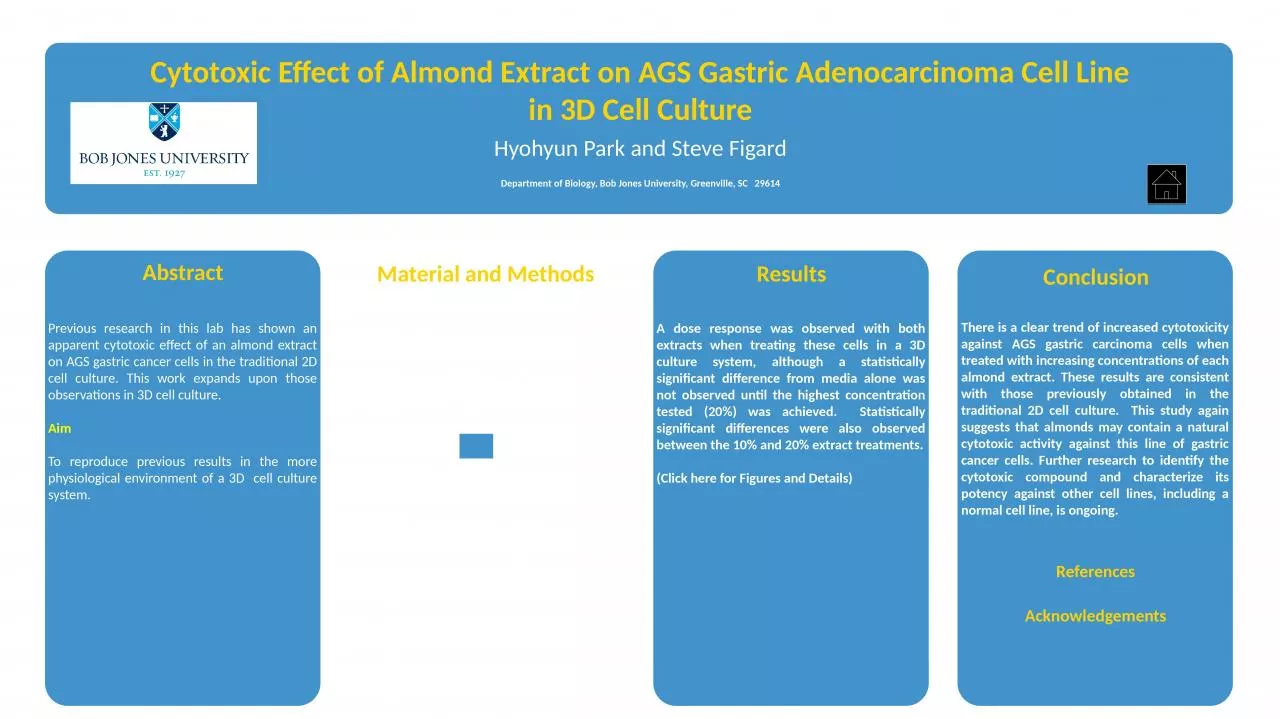

Hyohyun Park and Steve Figard Department of Biology Bob Jones University Greenville SC 29614 Abstract Previous research in this lab has shown an apparent cytotoxic effect of an almond extract on AGS gastric cancer cells in the traditional 2D cell culture This work expands upon those obser ID: 1040764
Download Presentation The PPT/PDF document "Cytotoxic Effect of Almond Extract on AG..." is the property of its rightful owner. Permission is granted to download and print the materials on this web site for personal, non-commercial use only, and to display it on your personal computer provided you do not modify the materials and that you retain all copyright notices contained in the materials. By downloading content from our website, you accept the terms of this agreement.
1. Cytotoxic Effect of Almond Extract on AGS Gastric Adenocarcinoma Cell Line in 3D Cell CultureHyohyun Park and Steve FigardDepartment of Biology, Bob Jones University, Greenville, SC 29614AbstractPrevious research in this lab has shown an apparent cytotoxic effect of an almond extract on AGS gastric cancer cells in the traditional 2D cell culture. This work expands upon those observations in 3D cell culture.AimTo reproduce previous results in the more physiological environment of a 3D cell culture system.Material and MethodsResultsA dose response was observed with both extracts when treating these cells in a 3D culture system, although a statistically significant difference from media alone was not observed until the highest concentration tested (20%) was achieved. Statistically significant differences were also observed between the 10% and 20% extract treatments.(Click here for Figures and Details)ConclusionThere is a clear trend of increased cytotoxicity against AGS gastric carcinoma cells when treated with increasing concentrations of each almond extract. These results are consistent with those previously obtained in the traditional 2D cell culture. This study again suggests that almonds may contain a natural cytotoxic activity against this line of gastric cancer cells. Further research to identify the cytotoxic compound and characterize its potency against other cell lines, including a normal cell line, is ongoing.Click here for the detailsReferencesAcknowledgements
2. Material and MethodsCell LineAGS (ATCC® CRL-1739TM) is a human gastric cancer line maintained using the standard cell culture practices. The cells are adherent and are removed from their 2D culture flask wall by brief trypsinization. Extract Preparation MethodsAlmond extracts were made with the previous pseudo-digestion protocol (Old Extract) and a simplified but equally effective non-enzymatic method (Fresh Extract). Whole almonds were added to 200 mL dH2O and blended in a Waring blender for 5 minutes at room temperature. The mixture was either clarified by centrifugation, sterile filtered through a 0.2 micron filter, and stored at 2-8°C until use, or submitted to the pseudo-digestion protocol described below.Pseudo-Digestion ProtocolFollowing the blender, the pH of the mixture was adjusted to 2.8 with HCl and incubated for 2 hours at 37°C with pepsin. Then the pH was adjusted to 5.7 with NaOH and a mixture of pancreatin and bile salts were added and incubated an additional 2 hours at 37°C. The digests were clarified by centrifugation, sterile filtered through a 0.2 micron filter, and stored at 2-8°C until use (within one week’s time).Cell AssayA Perfecta3D Hanging Drop Plate from 3D Biomatrix and Thermo Fisher’s Nunclon™ Sphera 96 well coated plate were used to culture AGS in 3D. The cells were cultured on the hanging drop plate until each drop had a cell sphere of approximately 150 µm diameter. Drops were transferred to a Nunclon 96 well coated plate and wells were treated with increasing concentrations of an almond extract. CellTiter 96® AQueous One Solution Cell Proliferation Assay (MTS) was carried out after 3 days using a 3 hour incubation with the dye. The MTS dye is metabolized by living cells to a product that has an absorbance at 490 nm; the higher the absorbance, the greater the number of viable cells present. The absorbance at 490 nm of the solutions in each well was then measured in a GENios Plus Tecan plate reader and the % viability calculated. ANOVA analysis of the results was done with JMP® 12 (SAS Institute, Cary, NC).
3. ResultsPrevious 2D Results:CURRENT 3D Results:
4. ReferencesBolling, Bradley W., Jeffrey B. Blumbery, C.-Y. Oliver Chen. (2010). The influence of roasting, pasteurization, and storage on the polyphenol content and antioxidant capacity of California almond skins. Food Chemistry. 123, 1040–1047.Davis, P. A., & Iwahashi, C. K. (2001). Whole almonds and almond fractions reduce aberrant crypt foci in a rat model of colon carcinogenesis. Cancer Letters, 165, 27–33.Sang, S., Lapsley, K., Jeong, W. S., Lachence, P. A., Ho, C. T., & Rosen, R. T. (2002). Antioxidative phenolic compounds isolated from almond skins (Prunus amygdalus Batsch). Journal of Agriculture and Food Chemistry, 50, 2459–2463.Santos, Isis S., Bruno M. Ponte, Prapaporn Boonme, Amélia M. Silva, Eliana B. Souto (2012). Nanoencapsulation of polyphenols for protective effect against colon–rectal cancer. Biotechnology Advances. Available online.Yan-Wei Hu, Chun-Yu Liu, Chong-Min Du, Jian Zhang, Wen Qian Wu, Zhen-Lun Gu (2009)., Induction of apoptosis in human hepatocarcinoma SMMC-7721 cells in vitro by flavonoids from Astragalus complanatus. Journal of Ethnopharmacology, 123, 293-301.We would like to thank Deanna Fry, Michael Pettit, and Taylor Johnson for help in the execution of these experiments and for discussions of the data and its interpretation. In addition, we would like to thank Dr. Amy Hicks for critical reading of the poster abstract, and Dr. Amy Tuck for arranging with Dr. Patricia Tate of Clemson University a donation of a vial of AGS cells for continued work.Acknowledgements